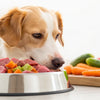Is Freeze-Dried Raw Dog Food Good? A Comprehensive Guide for Pet Parents
- Houndsy
Table of Contents
- Introduction
- What is Freeze-Dried Dog Food?
- Nutritional Benefits of Freeze-Dried Dog Food
- Potential Drawbacks and Safety Concerns
- How to Incorporate Freeze-Dried Dog Food Into Your Dog's Diet
- Choosing Quality Freeze-Dried Dog Food
- Conclusion
Introduction
As dog lovers, we know that the choices we make about our pets' diets can significantly affect their well-being. Did you know that the global demand for freeze-dried pet food is projected to reach approximately $525 million by 2025? This impressive growth is a clear sign that pet owners are increasingly seeking high-quality, minimally processed food options. Today, we will delve into the captivating world of freeze-dried raw dog food, exploring its benefits and potential pitfalls.
In this blog post, we aim to equip you with the knowledge you need to make informed feeding decisions for your furry friends. You will learn about what freeze-dried dog food is, how it’s made, its nutritional benefits, and important considerations for incorporating it into your pet's diet. By the end of this journey, our goal is to help you understand whether freeze-dried dog food is a good option for your canine companion, as well as how it can fit into their overall feeding routine.
What is Freeze-Dried Dog Food?
Freeze-dried dog food is a unique type of pet food that retains many of the nutritional qualities of raw ingredients while offering convenience and extended shelf life. So how is it made? The freeze-drying process begins by freezing raw ingredients—usually proteins like beef, chicken, or fish, along with fruits and vegetables. After freezing, the moisture is removed through a process called sublimation, where ice turns directly into vapor without passing through a liquid phase. This method preserves the food's structure, flavor, and essential nutrients.
The Composition of Freeze-Dried Dog Food
Freeze-dried dog food typically hosts a variety of ingredients, which can include:
- High-quality meats
- Fruits and vegetables
- Natural preservatives
- Vitamins and minerals
- Probiotics and antioxidants
Unlike many kibble and canned dog foods, freeze-dried diets usually do not contain grains or excess fillers. The high protein content can provide your dog with necessary energy and digestibility, making it an appealing option for many pet parents.
Nutritional Benefits of Freeze-Dried Dog Food
1. Retained Nutritional Integrity
One of the primary advantages of freeze-drying is that it preserves the nutrients in raw ingredients more effectively than traditional cooking methods. The freeze-drying process maintains protein levels, fat content, and essential vitamins that are often diminished in processed foods.
2. High Protein Content
The majority of freeze-dried dog foods boast higher protein levels compared to standard kibble. Proteins are vital for your dog's growth and maintenance of body tissues, including muscles, skin, and connective tissues. This is particularly crucial in puppies and active breeds, as well as in dogs requiring healing.
3. Digestibility
Because the freeze-drying process does not destroy enzymes and bacteria, many dogs find freeze-dried food easier to digest. The minimally processed diet can lead to improved digestion, resulting in fewer gastrointestinal upsets for some dogs.
4. Increased Palatability
Many dogs are naturally drawn to the taste, texture, and aroma of real meat. Pet owners often report that their dogs readily accept freeze-dried food, making it an excellent choice for picky eaters. Using freeze-dried food as a topper can help encourage dogs to eat their regular kibble!
5. Long Shelf Life
Another significant advantage is the extended shelf life of freeze-dried dog food. When properly stored, it can last for years without spoiling, providing peace of mind for pet parents seeking convenient feeding options.
Potential Drawbacks and Safety Concerns
While freeze-dried raw dog food can offer numerous benefits, it's essential to consider potential downsides before making the switch.
1. Pathogen Exposure
Although freeze-drying removes most moisture, it does not eliminate all pathogens. This means that there is still a risk of bacterial contamination, especially when dealing with raw ingredients. Salmonella and E. coli contamination can pose risks to both pets and pet parents. When using freeze-dried food, it's crucial to handle it safely by washing hands and surfaces after handling.
2. Cost Considerations
Freeze-dried food is generally more expensive than traditional kibble due to the complex manufacturing process. For budget-conscious pet parents, it may be worth evaluating how freeze-dried food can fit into a mixed feeding approach alongside other types of dog food.
3. Potential Nutrient Imbalance
Not all freeze-dried dog foods are created equal. Some brands may not be formulated to meet the nutritional standards set by the Association of American Feed Control Officials (AAFCO) for a complete diet. It's essential to choose high-quality options and ensure that the food you select provides balanced nutrition.
4. Special Dietary Needs
If your dog has specific health concerns, such as allergies or underlying health conditions, it is advisable to consult with your veterinarian. They can help determine whether freeze-dried food aligns with your pet's nutritional needs.
How to Incorporate Freeze-Dried Dog Food Into Your Dog's Diet
Now that we've explored what freeze-dried dog food is and its benefits and challenges, let's discuss how to integrate it into your pet's feeding routine for optimal results.
1. Full Meal Replacement
You can serve freeze-dried food as a standalone meal. Simply follow the packaging instructions for rehydrating the food appropriately. For example, a common ratio is one part freeze-dried food to two parts water, allowing the ingredients to rehydrate fully before meals.
2. Tasty Topper
For dogs already on a primarily kibble-based diet, adding freeze-dried food as a topper can enhance the palatability and nutritional value of their meals. It allows for variety in their cuisine without a complete diet overhaul.
3. Mix with Raw or Fresh Ingredients
If you enjoy preparing homemade food for your dog, consider using freeze-dried food in conjunction with raw or fresh ingredients. This can boost nutrient density, add variety, and create an enjoyable experience for your furry friend.
4. Transition Gradually
If you choose to switch your dog’s diet to freeze-dried food, do so gradually. Transitioning abruptly can lead to digestive upset. Introduce the new food slowly over several days, mixing it with their current food until they are fully accustomed to the change.
Choosing Quality Freeze-Dried Dog Food
To ensure that you're selecting high-quality freeze-dried dog food, here are some tips to consider:
- Research Brands: Look for reputable brands that prioritize sourcing quality ingredients. Transparency in their production processes is vital.
- Check Formulation: Choose freeze-dried products formulated to meet AAFCO standards to ensure that the diet is complete and balanced.
- Read Reviews: Do your homework by reviewing customer feedback from other pet owners who have tried the product.
- Seek Veterinary Guidance: Always consult your veterinarian before making significant changes to your dog’s diet. Their insight will help to inform your decision based on your dog's specific needs.
Conclusion
In conclusion, freeze-dried raw dog food presents a compelling option for pet parents seeking to provide their dogs with a minimally processed, nutrient-rich diet. While it offers numerous benefits, including convenience and high palatability, it is essential to weigh these against potential risks such as pathogen exposure.
By making informed decisions, we can choose the best dietary options for our beloved dogs. Whether you decide to make freeze-dried food a staple of your pet's diet or incorporate it as a complement to their existing food, we hope this guide has provided helpful insights on how freeze-dried raw dog food can enhance your dog's health and enjoyment at mealtime.
FAQs
1. Is freeze-dried dog food better than kibble?
While freeze-dried dog food is generally less processed and retains more nutrients, what is "better" often depends on your individual dog’s needs and preferences. Consulting your veterinarian is the best approach to determine the right diet for your pet.
2. Can I give my dog freeze-dried raw food every day?
Yes, many pet owners incorporate freeze-dried raw food into their dogs' daily diets. However, it's essential to ensure that the food meets nutritional standards and is balanced. Always consult with a veterinarian if you have questions about your dog's diet.
3. How should I store freeze-dried dog food?
Keep freeze-dried food in a cool, dry place and ensure the package is tightly sealed after use. Some manufacturers recommend refrigerating opened packages to maintain freshness.
4. Can my dog eat freeze-dried food straight from the bag?
Yes, most freeze-dried dog food is safe to eat without rehydration, although some dogs may prefer the texture and aroma after it has been rehydrated.
5. What are the best brands of freeze-dried dog foods?
There are several reputable brands offering high-quality freeze-dried dog food. Researching customer reviews, ingredient sourcing, and nutritional formulations can help you find the best options for your pet.
As we embark on a journey to elevate our dog’s feeding experience, we wholeheartedly support you in exploring various nourishing options. If you're looking for a convenient yet stylish way to manage your dog's food, our Houndsy Kibble Dispenser might just be the perfect solution!












